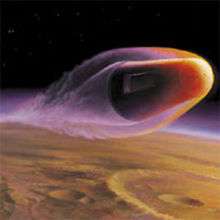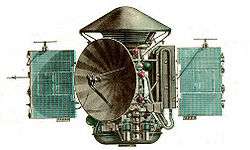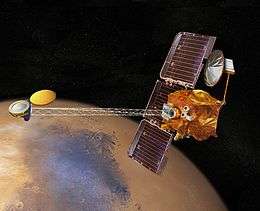Mars sample return mission

A Mars sample return mission (MSR) would be a spaceflight mission to collect rock and dust samples from Mars and to return them to Earth. Sample return would be a very powerful type of exploration, because analysis is freed from the time, budget, and space constraints of spacecraft sensors.[1] Any of Earth's laboratories could study a sample.[1]
According to Louis Friedman, Executive Director of The Planetary Society, a Mars sample return mission is often described by the planetary science community as one of the most important robotic space missions, due to its high expected scientific return on investment.
Over time, several missions were planned but none of the proposed missions got beyond the planning phase. The three latest proposals for a MSR mission are a NASA-ESA proposal, a Russian proposal (Mars-Grunt), and a Chinese proposal.
MSR was the highest priority Flagship Mission proposed for NASA by the Planetary Decadal Survey 2013–2022: The Future of Planetary Science.[2]
Scientific value
.jpg)
The return of Mars samples would be beneficial to science by allowing more extensive analysis to be undertaken of the samples than could be done by instruments painstakingly transferred to Mars. Also, the presence of the samples on Earth would allow scientific equipment to be used on stored samples, even years and decades after the sample return mission.[3]
In 2006, MEPAG identified 55 important future science investigations related to the exploration of Mars. In 2008, they concluded that about half of the investigations "could be addressed to one degree or another by MSR", making MSR "the single mission that would make the most progress towards the entire list" of investigations. Moreover, it was found that a significant fraction of the investigations cannot be meaningfully advanced without returned samples.[4]
One source of Mars samples is what are believed to be Martian meteorite's, which are rocks from Mars that made their way to Earth. Of over 61,000 meteorites that have been found on Earth, 132 were identified as Martian as of 3 March 2014.[5] These meteorites are thought to be from Mars because they have elemental and isotopic compositions that are similar to rocks and atmosphere gases analyzed by spacecraft on Mars.[6]
In 1996 the possibility of Life on Mars was seriously revived when some sort of remains of life might have been found on a Mars meteor (see ALH84001).[7] This lead a to a big interest in Mars sample return, and several different architectures were considered.[8] NASA administrator Goldin laid out three options for MSR, "paced," "accelerated," and "aggressive".[9] It was thought that MSR could be done for less than 100 million USD a year, with something similar to then-current Mars exploration budgets.[10]
History

The Soviet Union planned a Mars sample return mission, Mars 5NM, in 1975 but it was cancelled due to the repeated failures of the N1 rocket that would have been used to launch it. A double sample return mission, Mars 5M (Mars-79), was planned for 1979 was cancelled due to complexity and technical problems.
For at least three decades, Western scientists have advocated the return of geological samples from Mars.[11] One mission was originally planned to return samples by 2008,[12] but was cancelled following a review of the program.[13] A NASA-ESA plan was aborted in 2012.[14]
The United States' Mars Exploration Program, formed after Mars Observer's failure in September 1992,[15] supported a Mars sample return.[15] One example of a mission architecture was the Groundbreaking Mars Sample Return by MacPhereson in the early 2000–2010 decade.[16]
In early 2011, the National Research Council's Planetary Science Decadal Survey, which laid out mission planning priorities for the period 2013–2022 at the request of NASA and the NSF, declared a MSR campaign its highest priority Flagship Mission for that period.[17] In particular, it endorsed the proposed Mars Astrobiology Explorer-Cacher (MAX-C) mission in a "descoped" (less ambitious) form, although this mission plan was officially cancelled in April 2011.
In September 2012, the United States' Mars Program Planning Group endorsed sample return after evaluating long-term Mars' plans.[18][19]
NASA–ESA plan

In mid-2006, the international Mars Architecture for the Return of Samples (iMARS) Working Group was chartered by the International Mars Exploration Working Group (IMEWG) to outline the scientific and engineering requirements of an internationally sponsored and executed Mars sample return mission in the 2018–2023 time frame.[4]
In October 2009, NASA and ESA established the Mars Joint Exploration Initiative to proceed with the ExoMars mission, whose ultimate aim is "the return of samples from Mars in the 2020s".[21][22] A first step in this was one particular proposal, a joint project between NASA and ESA called ExoMars, would launch in 2018[3][23] with unspecified missions to return the sample itself expected in the 2020–2022 time frame.[24] The cancellation of the caching rover MAX-C and later NASA withdrawal from ExoMars, pushed back a sample return mission to an undetermined date.
Due to budget limitations the MAX-C mission, which was the first NASA-ESA mission leading to a MSR, was canceled in 2011 and the overall plan in 2012.[14] The pull-out was described as "traumatic" for the science community.[14]
NASA proposals
In September 2012, NASA announced plans to further study several strategies of returning a sample of Mars to Earth – including a multiple launch scenario, a single launch scenario and a multiple rovers scenario – for a mission beginning as early as 2018.[25]

One-launch architecture
Solar-electric propulsion might allow a sample return by launching all elements in a single launch.[26] By using a Hall thruster powered by solar energy, less propellant would be needed, allowing the lander and return spacecraft to be launched together.[26]
Two-launches architecture
In this scenario, the sample return mission would span two launches at an interval of about four years. The first launch would be for the orbiter, the second for the lander.[27] The rest of the mission would follow in the same way as the one-element mission design.
Three-launches architecture
One concept is to have the sample return mission split into a total of three launches.[27] In this scenario, the sample-collection rover (e.g. MAX-C) would be launched separately to land on Mars first, and carry out analyses and sample collection over a lifetime of at least 500 Sols (Martian days).[28]
Four years later, the orbiter would be launched, followed by the lander including the Mars Ascent Vehicle (MAV). Instead of a full-blown sample-collection rover, the lander would bring a smaller, simple "fetch rover", whose sole function would be to retrieve the sample container from the sample-collection rover, and return it to the lander where it would be loaded onto the MAV.[29]
This design would ease the schedule of the whole mission, giving controllers time to carry out the required operations. Furthermore, by spreading the landed mass across two payloads (the sample-collection rover and later the MAV), the program could rely on the successful landing system developed for the Mars Science Laboratory, avoiding the costs and risks associated with developing and testing yet another landing system from scratch.[27] Another three-launch plan would be to have one launch be a sample collecting rover, a second launch carrier a fetch rover and Mars ascent stage (take sample to space), and finally a spacecraft to return the sample back to Earth.[30]
SCIM

SCIM ("Sample Collection for Investigation of Mars") was a low-cost low-risk Mars sample return mission design, proposed in the Mars Scout Program.[31] SCIM would return dust and air samples without landing or orbiting,[31] by dipping through the atmosphere as it collects Mars material.[32] It uses heritage from the successful Stardust and Genesis sample return missions.[32]
Additional plans
Russia
A Russian Mars sample return mission concept is Mars-Grunt.[33][34][35][36][37] It is meant to use Phobos-Grunt design heritage.[34] Plans as of 2011 envisioned a two-stage architecture with an orbiter and a lander (but no roving capability),[38] with samples gathered from the immediate surroundings of the lander by a robotic arm.[39]
China
China has plans for a Mars sample return mission by 2030.[40][41] The mission plan combines elements of remote sensing of the surface, soft landing, using a rover to gather samples, then sample return.[41]
France
France has worked towards a sample return for many years.[42] This included the preparation of laboratories for returned samples, and numerous proposals.[42] They worked on the development of a Mars sample return orbiter, which would capture and return the samples as part of a joint mission with either the United States, or other European countries.[42]
Japan
On 9 June 2015, the Japanese Aerospace Exploration Agency (JAXA) unveiled a plan to retrieve samples from one of the moons of Mars named MMX (Martian Moons Explorer).[43] This mission will build on the expertise to be gained from the Hayabusa 2 and SLIM missions.[44] Japan has also shown interest on participating in an international Mars sample return mission.
Potential for back contamination

Since it is currently unknown whether life forms exist on Mars, the mission could potentially transfer viable organisms resulting in back contamination—the introduction of extraterrestrial organisms into Earth's biosphere. The scientific consensus is that the potential for large-scale effects, either through pathogenesis or ecological disruption, is extremely small.[45][46][47][48][49] Nevertheless, returned samples from Mars will be treated as potentially biohazardous until scientists can determine that the returned samples are safe. The goal is to reduce the probability of release of a Mars particle to less than one in a million.[46] In addition, the proposed NASA Mars Sample Return mission will not be approved by NASA until the National Environmental Policy Act (NEPA) process has been completed.[50] The NEPA process would require a public review of all potential impacts that could result from MSR, including worst case back contamination scenarios. It is likely that a formal Environmental Impact Statement (EIS) would have to be prepared.[51] Furthermore, under the terms of Article VII of the Outer Space Treaty and probably various other legal frameworks, were a release of organisms to occur, the releasing nation or nations would be liable for any resultant damages.[51][52]
Part of the sample return mission would be to prevent contact between the Martian environment and the exterior of the sample container.[46][50] In order to eliminate the risk of parachute failure, the current plan is to use the thermal protection system to cushion the capsule upon impact (at terminal velocity). The sample container will be designed to withstand the force of the impact.[50] To receive the returned samples, NASA proposed a specially designed Biosafety Level 4 containment facility, the Mars Sample Return Receiving facility (MSRRF).[53] Not knowing what properties (e.g., size) any Martian organisms might exhibit is a complication in design of such a facility.[54]
The International Committee Against Mars Sample Return[55] believes that the risk of contamination is much more severe than NASA's assessment. Consequently, they advocate much more in situ research before undertaking MSR.[55][56] Other scientists and engineers—notably Robert Zubrin of the Mars Society—argue that contamination risk is functionally zero and there is little need to worry. They cite, among other things, lack of any verifiable incident although trillions of kilograms of material have been exchanged between Mars and Earth due to meteor impacts.[57]
NASA Sample Return Robot Challenge
The Sample Return Robot Challenge, as part of NASA's Centennial Challenges program, offered a total $1.5 million to teams that can build fully autonomous robots that can find, retrieve, and return up to 10 different sample types within a large outdoor environment (80,000 m2).[58] The challenge started in 2012 and ended in 2016. Over 50 teams competed during the 5-year history of the NASA Challenge. A robot named Cataglyphis, developed by Team Mountaineers from West Virginia University completed the final challenge in 2016.
Example sample return spacecraft

NASA S87-29632 (March 18, 1987): This series of black and white drawings was done as a result of NASA's adoption of its Advisory Council's recommendation for an aggressive unmanned exploration of Mars. The returnable hardware program is planned as a precursor to a manned exploration of Mars in the next century. The Johnson Space Center in Houston and the Jet Propulsion Laboratory in Pasadena both have task teams outlining preliminary scenarios on how Mars sample-return missions could be flown using launch vehicles expected to be available late in the 1990s. If approved and funded, the Mars-bound spacecraft would be launched in 1998 and return with martian soil, rock and atmosphere samples in the year 2001. The current rover technology includes a stereo camera vision system, sensors, a computer brain, controlled manipulators and a drill system for acquiring samples. The proposed vehicle would have a mass of no more than 700 kilograms (1,540 pounds), be six meters long and two meters across.[59]
See also
- ExoMars (Aurora multi-mission flagship)
- Fobos-Grunt (Russian-Chinese Mars Moon sample return Mission) crashed
- Mars Astrobiology Explorer-Cacher (MAX-C) cancelled in 2012
- Mars meteorite
- Red Dragon
- Mars 2020 rover (May include sample-cacher)
References
- 1 2 Trieman, et al. – Groundbreaking Sample Return from Mars: The Next Giant Leap in Understanding the Red Planet
- ↑ "Science Strategy - NASA Solar System Exploration".
- 1 2 Mars Sample Return (from the NASA website. Accessed 2008-05-26.)
- 1 2 http://mepag.jpl.nasa.gov/reports/iMARS_FinalReport.pdf
- ↑ NWA 6963
- ↑ Treiman, A.H.; et al. (October 2000). "The SNC meteorites are from Mars". Planetary and Space Science. 48 (12–14): 1213–1230. Bibcode:2000P&SS...48.1213T. doi:10.1016/S0032-0633(00)00105-7.
- ↑ http://www2.jpl.nasa.gov/snc/nasa3.html
- ↑ http://www2.jpl.nasa.gov/snc/nasa3.html
- ↑ http://www2.jpl.nasa.gov/snc/nasa3.html
- ↑
- ↑ Space Studies Board; National Research Council (2011). "Vision and Voyages for Planetary Science in the Decade 2013–2022" (PDF). National Academies Press. p. 6‑21.
- ↑ Return to Mars. National Geographic Magazine, August 1998 issue
- ↑ "MarsNews.com :: Mars Sample Return". 27 February 2015.
- 1 2 3 "International cooperation called key to planet exploration". 22 August 2012.
- 1 2 Shirley, Donna. "Mars Exploration Program Strategy: 1995–2020" (PDF). American Institute of Aeronautics and Astronautics. Retrieved 18 October 2012.
- ↑ Groundbreaking Sample Return from Mars: The Next Giant Leap in Understanding the Red Plan
- ↑ http://www.livestream.com/2011lpsc/video?clipId=pla_18e48f98-4a78-4acc-ad2a-29c7a8ae326c&utm_source=lslibrary&utm_medium=ui-thumb
- ↑ Mars Planning Group Endorses Sample Return
- ↑ Summary of the Final Report
- ↑
- ↑ "NASA and ESA Establish a Mars Exploration Joint Initiative". NASA. July 8, 2009. Retrieved 2009-11-09.
- ↑ Christensen, Phil (April 2010). "Planetary Science Decadal Survey: MSR Lander Mission" (PDF). JPL. NASA. Retrieved 2012-08-24.
- ↑ "BBC NEWS - Science/Nature - Date set for Mars sample mission".
- ↑ "Mars Sample Return: bridging robotic and human exploration". European Space Agency. 21 July 2008. Retrieved 2008-11-18.
- ↑ Wall, Mike (September 27, 2012). "Bringing Pieces of Mars to Earth: How NASA Will Do It". Space.com. Retrieved September 28, 2012.
- 1 2 Dr. David Y. Oh, et al. -Single Launch Architecture for Potential Mars Sample Return Mission Using Electric Propulsion (2009) – JPL/Caltech(.pdf)
- 1 2 3 "Future Planetary Exploration: New Mars Sample Return Plan". 8 December 2009.
- ↑ Strategic Technology Development for Future Mars Missions (2013–2022) (PDF) 15 September 2009
- ↑ 'Bringing back Mars life' MSNBC News, February 24, 2010 by Alan Boyle.
- ↑ Witze, Alexandra (15 May 2014). "NASA plans Mars sample-return rover". 509 (7500): 272–272. doi:10.1038/509272a.
- 1 2 Jones, S.M.; et al. (2008). "Ground Truth From Mars (2008) – Mars Sample Return at 6 Kilometers per Second: Practical, Low Cost, Low Risk, and Ready" (PDF). USRA. Retrieved September 30, 2012.
- 1 2 Wadhwa, et al. – SCIM (2012)
- ↑ Roscosmos – Space missions Published by The Space Review (page 9) on 2010
- 1 2 Dwayne A. DayMonday, November 28, 2011 (2011-11-28). "'Red Planet blues (Monday, November 28, 2011)". The Space Review. Retrieved 2012-01-16.
- ↑ Kramnik, Ilya (April 18, 2012). "Russia takes a two-pronged approach to space exploration". Russia & India Report. Retrieved 2012-04-18.
- ↑ Russia To Study Martian Moons Once Again. Mars Daily July 15, 2008.
- ↑ Major provisions of the Russian Federal Space Program for 2006–2015. "1 spacecraft for Mars research and delivery of Martian soil to the Earth."
- ↑ Russian Space Probes: Scientific Discoveries and Future Missions. By Brian Harvey, Olga Zakutnyaya. (p 475)
- ↑ Roscosmos – Space missions Published by The Space Review (page 9) on 2010
- ↑ English.news.cn (2012-10-10). "China considers more Mars probes before 2030". news.xinhuanet.com. Retrieved 2012-10-14.
- 1 2 Staff Writers Beijing (AFP) (2012-10-10). "China to collect samples from Mars by 2030: Xinhua". marsdaily.com. Retrieved 2012-10-14.
- 1 2 3 Counil, J.; Bonneville, R.; Rocard, F. (1 January 2002). "The french involvement in Mars sample return program" – via NASA ADS.
- ↑ "JAXA plans probe to bring back samples from moons of Mars". 10 June 2015 – via Japan Times Online.
- ↑ Torishima, Shinya (June 19, 2015). "JAXAの「火星の衛星からのサンプル・リターン」計画とは". Mynavi News (in Japanese). Retrieved 2015-10-06.
- ↑ http://mepag.nasa.gov/reports/iMARS_FinalReport.pdf Preliminary Planning for an International Mars Sample Return Mission Report of the International Mars Architecture for the Return of Samples (iMARS) Working Group June 1, 2008
- 1 2 3 European Science Foundation – Mars Sample Return backward contamination – Strategic advice and requirements July, 2012, ISBN 978-2-918428-67-1 – see Back Planetary Protection section. (for more details of the document see abstract )
- ↑ Joshua Lederberg Parasites Face a Perpetual Dilemma Volume 65, Number 2, 1999 / American Society for Microbiology News 77.
- ↑ Assessment of Planetary Protection Requirements for Mars Sample Return Missions (Report). National Research Council. 2009.
- ↑ http://planetaryprotection.nasa.gov/summary/msr Mars Sample Return: Issues and Recommendations. Task Group on Issues in Sample Return. National Academies Press, Washington, DC (1997).
- 1 2 3 http://mepag.jpl.nasa.gov/meeting/mar-10/Li2-MSR_Dis-for-MEPAG3-17_tech_updates.pdf Mars Sample Return Discussions As presented on February 23, 2010
- 1 2 M. S. Race Planetary Protection, Legal Ambiguity, and the Decision Making Process for Mars Sample Return, Adv. Space Res. vol 18 no 1/2 pp (1/2)345-(1/2)350 1996
- ↑ "Treaty on Principles Governing the Activities of States in the Exploration and Use of Outer Space, including the Moon and Other Celestial Bodies". Retrieved 2013-07-13.
- ↑ "Mars Sample Return Receiving Facility" (PDF).
- ↑ Mars Sample Return Receiving Facility – A Draft Test Protocol for Detecting Possible Biohazards in Martian Samples Returned to Earth (PDF) (Report). 2002.
- 1 2 "International Committee Against Mars Sample Return - Planetary Protection".
- ↑ Barry E. DiGregorio The dilemma of Mars sample return August 2001 Vol. 31, No. 8, pp 18–27.
- ↑ Zubrin, Robert, 2010, "Human Mars Exploration: The Time Is Now": J. Cosmol., v. 12, p. 3549-3557.
- ↑ Harbaugh, Jennifer (2015-07-15). "NASA's Centennial Challenges: Sample Return Robot Challenge". Retrieved 2016-09-16.
- ↑ "Photo-s87_29632".
External links
- ESA's Mars Sample Return page
- "ESA Open to Mars Sample Return". ABC News. 2007-09-27.
- Mars Sample Return Lander Mission Profile by NASA's Solar System Exploration
- Mars Sample Return Discussions As presented on February 23, 2010


.jpg)
.jpg)